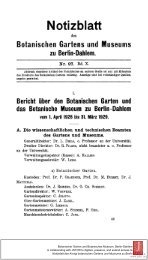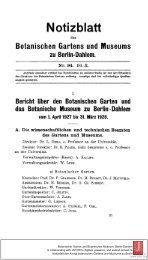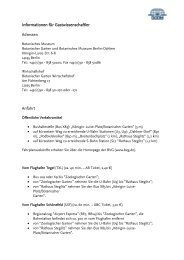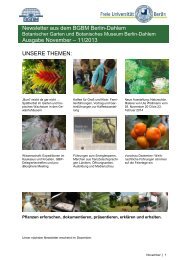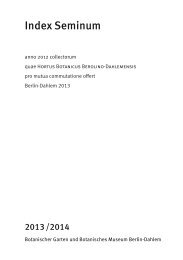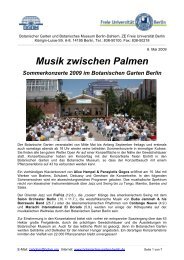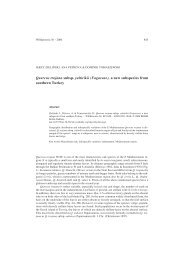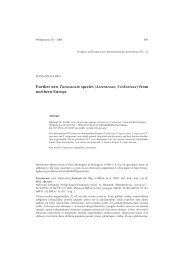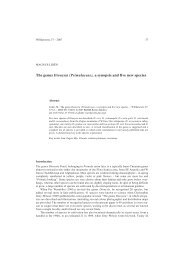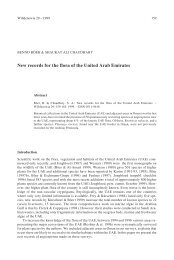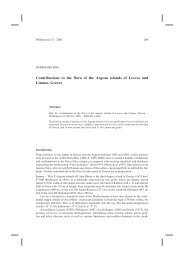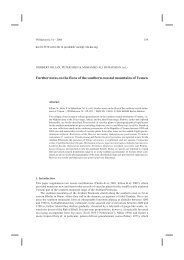Full text PDF - Botanischer Garten und Botanisches Museum Berlin ...
Full text PDF - Botanischer Garten und Botanisches Museum Berlin ...
Full text PDF - Botanischer Garten und Botanisches Museum Berlin ...
Create successful ePaper yourself
Turn your PDF publications into a flip-book with our unique Google optimized e-Paper software.
Willdenowia 36 – 2006 537<br />
MARK R. D. SEAWARD & HARRIE J. M. SIPMAN<br />
An updated checklist of lichenized and lichenicolous fungi for Egypt<br />
Abstract<br />
Seaward, M. R. D. & Sipman, H. J. M.: An updated checklist of lichenized and lichenicolous fungi<br />
for Egypt. – Willdenowia 36 (Special Issue): 537-555. – ISSN 0511-9618; © 2006 BGBM <strong>Berlin</strong>-<br />
Dahlem.<br />
doi:10.3372/wi.36.36151 (available via http://dx.doi.org/)<br />
A revised lichen checklist for Egypt, the first to be published since 1901, is presented. It is based<br />
on a detailed literature survey supported by a limited study of herbarium material. The list includes<br />
163 taxa of lichenized and lichenicolous fungi, six of which are newly recorded for the<br />
country. Synonymic interpretation, a short historical backgro<strong>und</strong> and a comprehensive bibliography<br />
are also provided. The total lichen flora of Egypt is estimated to comprise no more than 250<br />
species with a remarkably poor representation of many common groups, such as Parmeliaceae.<br />
Key words: lichen biodiversity, archaeology, ethnobotany, Mediterranean flora.<br />
Introduction<br />
Egypt has the distinction of providing the world’s oldest lichen records, since they were used in<br />
mummification more than three millennia ago. However, the species used, Pseudevernia furfuracea,<br />
may well have been imported, probably from Greece. In the Mediterranean region its optimal<br />
habitat would be mountain forest, and it is doubtful if it would be fo<strong>und</strong> locally, certainly in<br />
sufficient quantities; however, it must be acknowledged that there have been dramatic changes in<br />
the N African environment over the past three millennia and there are recent reports of P. furfuracea<br />
from the Middle East (John & al. 2004). The function of lichens in mummification is often<br />
given as ‘aromatic’; although lichens are indeed used as a fixative in order to enhance aromas<br />
from other plants, which may have been one of its purposes in such cases, they are also noted for<br />
their antibiotic properties (Richardson 1988). Samples of P. furfuracea taken from mummies are<br />
to be fo<strong>und</strong> in collections throughout the world. Material extracted from a XXI dynasty tomb<br />
(see Germer 1988), housed in the Botanical <strong>Museum</strong> <strong>Berlin</strong>-Dahlem (B), is illustrated in Figs. 1<br />
and 2.<br />
For centuries lichens have been used not only for pharmaceutical purposes but have also provided<br />
food for humans (e.g. Schweinfurth 1918), used not for their culinary value but rather as a<br />
bulking ingredient; this can still be seen in Middle Eastern markets, where sacks of imported material,<br />
usually Parmotrema spp., are often for sale. The Biblical reference to manna is often inter-
538 Seaward & Sipman: Checklist of lichenized and lichenicolous fungi for Egypt<br />
Fig. 1. Pseudevernia furfuracea fragments: offering from an ancient Egyptian grave, in decorative early 20th<br />
century box. – Collection of Georg Schweinfurth at the Botanical <strong>Museum</strong> <strong>Berlin</strong>-Dahlem.
Willdenowia 36 – 2006 539<br />
Fig. 2. Label (handwritten by G. Schweinfurth) for the sample of Fig. 1. Translation: “50. Parmelia furfuracea<br />
Ach. from hidden grave of XXI dynasty in Dez el bahari, Thebe. Laid down as offering. Large grave<br />
discovery of 1881. Fo<strong>und</strong> by E. Brugsch”. – Collection of Georg Schweinfurth at the Botanical <strong>Museum</strong><br />
<strong>Berlin</strong>-Dahlem.<br />
preted as referring to the lichen Aspicilia esculenta (Pall.) Flagey, whose thick wrinkled crusts<br />
when detached from rocks in significant quantities can be exploited as food or as fodder for the<br />
livestock (Richardson 1988). However, although this lichen is widespread in the Middle East, we<br />
have not fo<strong>und</strong> any published record from Egypt. It should be noted that there are several other<br />
interpretations of “manna from heaven”.<br />
The earliest known herbarium specimen of a lichen from Egypt, namely Cladonia convoluta,<br />
was collected in about 1750 by Fredric Hasselquist (1722-52) and is currently housed in the<br />
Uppsala Herbarium (UPS) – see database http://www-hotel.uu.se/evolmuseum/fytotek/. The first<br />
published records appear in two major works by Alire Raffeneau Delile (1778-1850): Flore<br />
d’Egypte and Florae Aegyptiacae Illustratio. Both were published in 1813, and contain references,<br />
the former with descriptions and figures of 11 species, to lichens seen by Delile during his<br />
investigations on behalf of Napoleon in 1798-1801. The second work lists 12 species from<br />
Egypt, some from the summit of the second Gizeh pyramid, together with 4 species on sale by<br />
Egyptian pharmacists, but imported from Greece. The Delile herbarium in Montpellier (MPU)<br />
requires a detailed examination as it may include type material for possibly nine species.<br />
An historical resumé by Müller (1880a) provides details of the collections made by numerous<br />
botanists over the next three-quarters of a century, including Guiseppe Raddi (1770-1829), Christian<br />
Gottfried Ehrenberg (1795-1876), Charles du Bois Larbalastier (1838-1911), Paul Friedrich<br />
August Ascherson (1834-1913) and George August Schweinfurth (1836-1925). Other 19th and<br />
early 20th century botanists known to have collected lichens from Egypt include Karl Georg<br />
Theodor Kotschy (1813-66), Ernst Sickenberger (1831-95), Fritz Kerner von Marilaun (1866-<br />
1944), William Barbey (1842-1914), Ludwig Rütimeyer (1825-95, see Müller 1891), Johann<br />
Andreas Kneucker (1862-1946) and Joseph Friedrich Nicolaus Bornmüller (1862-1948). The major<br />
published works itemising many of these collections are provided by Nylander (1864, 1876),<br />
Müller (1880a-c, 1884), Stizenberger (1890, 1891), Sickenberger (1901) and Steiner (1893,<br />
1916), but it should be noted that some of these works repeat earlier records, with some ambiguity<br />
resulting from synonymic interpretation (and erratic use of forma and variety), and, in the case of<br />
Sickenberger, considerable misspelling of Latin nomenclature.<br />
Since those days, only a few botanists have recorded, or indeed studied, Egyptian lichens. For<br />
this period, the following are known to have made collections: M. Steiner, V. Täckholm, E.<br />
Albertshofer, K. H. Batanouny, I. Helmy, R. Moberg, M. Galun, J. Garty, L. Boulos, J.-P.<br />
Frahm and M. R. D. Seaward, and the following publications, usually monographs, include Egyptian<br />
records: Magnusson (1929), Motyka (1936-38), Degelius (1954), Werner (1966), Galun &<br />
Marton (1970), Galun & Garty (1972, 2001), W<strong>und</strong>er (1974), Tehler (1983), Mayrhofer (1984),<br />
Lumbsch (1989), Egea (1989), Moreno & Egea (1990, 1992), Timdal (1991), Alonso & Egea<br />
(1994), Breuss (1994), Nordin (2000) and Frödén & Lassen (2004).<br />
The purpose of this study is to present an up-to-date survey of all published information,<br />
which is now scattered over the literature, and thus to facilitate further study of the Egyptan lichen<br />
flora. Consequently the checklist, which follows, is by no means exhaustive, since only lim-
540 Seaward & Sipman: Checklist of lichenized and lichenicolous fungi for Egypt<br />
ited material from the herbaria of <strong>Berlin</strong> (B), Farlow (FH), Uppsala (UPS) and M. R. D. Seaward<br />
has been examined as yet. A more precise evaluation can be made, particularly in respect of synonymic<br />
revision, once a more detailed examination of Egyptian material known, or thought, to<br />
be in the herbaria of BM, BRSL, C, COLO, FH, G, H, K, L, LE, LZ, M, MPU, P, S and UPS (abbreviations<br />
according to Holmgren & Holmgren 1998-ongoing) has been <strong>und</strong>ertaken. In the<br />
meantime it is hoped that our listing will contribute to the objectives of OPTIMA in seeking a<br />
better <strong>und</strong>erstanding of the biodiversity and biogeographical status of the Mediterranean flora<br />
(Nimis 1996).<br />
Results<br />
Altogether 157 lichenized fungi (149 species and 8 infraspecific taxa) and 6 lichenicolous fungi<br />
are now reported for Egypt. Since only a few new collections were available for study, it is not<br />
surprising that few additional species were fo<strong>und</strong>, namely Caloplaca flavescens, Fulgensia subbracteata,<br />
Lecania spadicea, Lecanora agardhiana, L. dispersa and Opegrapha celtidicola.<br />
As expected for a country largely consisting of desert, in which at least five millennia of human<br />
settlement have probably had a devastating influence on natural habitats, the number of reported<br />
species is modest. In comparison, for Syria, with a similar desert-like environment but<br />
with some high mountain ranges, 399 taxa were reported recently (John & al. 2004) and for the<br />
nearby Santorin archipelago, measuring only 76 km 2 , almost treeless and completely destroyed<br />
in a volcanic explosion some 3500 years ago, 170 species are known (Sipman & Raus 1999).<br />
It is tempting to estimate the total number of lichen species that occur in Egypt. There has been<br />
no recent intensive fieldwork by any trained lichenologist, which normally means that many additional<br />
species can be expected. However, many common and conspicuous lichen groups likely to<br />
be fo<strong>und</strong> by unexperienced observers are absent from the checklist below, such as species of<br />
Pertusaria, the Lecanora subfusca group and foliose Parmeliaceae and Physciaceae. This suggests<br />
that the lichen flora is really very limited and probably does not exceed 250 species.<br />
In spite of its small size, the lichen flora is of considerable interest because it shows some remarkable<br />
features. Significantly, foliose lichens are very scarce, only being represented by the<br />
genera Xanthoria (7 species reported) and Physcia (1 species), while foliose Parmeliaceae, which<br />
are among the first lichens to be collected in any part of the world, are apparently absent. Remarkably<br />
the fruticose growth form is better represented, with members of the genera Ramalina, Roccella,<br />
Seirophora and Tornabea. At taxonomic level, the dominance of Teloschistaceae is conspicuous<br />
(39 taxa), which cannot only be explained by their conspicuous colours, since blackfruited<br />
species are also involved. The next largest families represented are Roccellaceae (16 taxa)<br />
and Physciaceae (12 taxa).<br />
Annotated checklist<br />
For each accepted species the pertinent literature references are presented. Occasional notes are<br />
provided on selected specimens, when seen by the authors, and on the interpretation of the references.<br />
The synonyms used in published Egyptian records are also listed. Lichenicolous fungi are<br />
indicated by “LF”; names preceded by an asterisk (*) are newly reported for Egypt, and names<br />
followed by an asterisk (*) have their nomenclatural types from Egypt.<br />
Nomenclature, including synonymic interpretation, is based on a wide variety of sources,<br />
more particularly Nimis & Martellos (2003). Infraspecific taxa without modern taxonomic treatment<br />
have been included in the main species. Misspellings of Sickenberger are listed as separate<br />
entries when particularly confusing. No references are presented to evidently mere literature citations<br />
as in, e.g., Zahlbruckner’s Catalogus and Stizenberger’s Lichenaea Africana.<br />
Acarospora areolata Reichert & Galun – Galun & Garty 1972: 246; Temina & al. 2005a: 437;<br />
Temina & al. 2005b: 44.
Willdenowia 36 – 2006 541<br />
A. atrata Hue – Nylander 1864: 67 as Lecanora fuscata, reidentification according to Galun &<br />
Garty 1972: 243.<br />
A. bornmuelleri Stein – Galun & Garty 1972: 246; Temina & al. 2005a: 439; Temina & al.<br />
2005b: 45.<br />
A. cervina A. Massal. – Müller 1880b: 43 as Placodium cervinum; Sickenberger 1901: 327 as<br />
Lecanora cervina.<br />
A. interrupta Vain. = A. strigata<br />
A. nodulosa var. reagens (Zahlbr.) Clauzade & Cl. Roux – Nylander 1864: 67 as Lecanora schleicheri<br />
f. radicans; Müller 1880b: 43 as Placodium schleicheri f. radicans; Sickenberger 1901:<br />
327 as Lecanora dealbata var. radicans; Magnusson 1929: 272 as A. reagens f. radicans;<br />
Galun 1970: 47, Galun & Garty 2001: 100 as A. reagens f. radicans; Temina & al. 2005a:<br />
444; Temina & al. 2005b: 51.<br />
A. placenta (Ehrenb.) Hue* – Nylander 1864: 68 as Lecanora placenta; Magnusson 1929: 359.<br />
A. reagens f. radicans (Nyl.) H. Magn. = A. nodulosa var. reagens<br />
A. rufescens Bausch – Nylander 1876: 284 as Lecanora rufescens; Müller 1880b: 43 as Placodium<br />
rufescens; Sickenberger 1901: 327 as Lecanora rufescens.<br />
A. schleicheri f. radicans = A. nodulosa var. reagens<br />
A. strigata (Nyl.) Jatta – Nylander 1864: 67 as Lecanora interrupta; Müller 1880b: 43 as Placodium<br />
interruptum; Sickenberger 1901: 327 as Lecanora interrupta; Magnusson 1929:<br />
208; Galun & Garty 1972: 243 as Acarospora interrupta.<br />
Amphiloma callopisma Müll. Arg. = Caloplaca aurantia<br />
A. callopisma var. centroleucum (A. Massal.) Müll. Arg. = Caloplaca aurantia<br />
A. callopisma var. exalbatum Müll. Arg.* = Caloplaca aurantia<br />
A. ehrenbergii Müll. Arg.* = Caloplaca ehrenbergii<br />
A. erythrinum Müll. Arg.* = Caloplaca erythrina<br />
A. erythrinum var. cryptocarpum Müll. Arg.* = Caloplaca erythrina<br />
A. erythrinum var. pulvinatum Müll. Arg.* = Caloplaca erythrina var. pulvinatum<br />
A. murorum (Hoffm.) Körb. = Caloplaca saxicola<br />
Anapyrenium* aegyptiacum Müll. Arg.* – Müller 1880c: 81; Sickenberger 1901: 330 as Endocarpon<br />
aegyptiacum; Galun & Garty 1972: 251.<br />
Arthonia adhaerens Müll. Arg.* – Müller 1880c: 80; Sickenberger 1901: 329.<br />
A. albopulverea Nyl. – Müller 1884: 18 as Arthothelium xylographoides; Sickenberger 1901: 330<br />
as Arthonia xylographoidis [= xylographoides]; Galun & Garty 1972: 243 as Arthothelium<br />
xylographoides.<br />
A. alexandrina Nyl.* – Nylander 1876: 285; Müller 1880c: 80; Sickenberger 1901: 329.<br />
A. confinis Stizenb.* – Sickenberger 1901: 330.<br />
A. dispersula Nyl.* – Nylander 1876: 285; Müller 1880c: 80; Sickenberger 1901: 329.<br />
A. palmicola Ach.* – Acharius 1814: 5; Nylander 1876: 284; Müller 1880c: 80, 1884: 18;<br />
Sickenberger 1901: 329.<br />
A. punctiformis var. subeminula Nyl.* – Nylander 1876: 284; Müller 1880c: 80; Sickenberger<br />
1901: 330.<br />
A. varians (Davies) Nyl. – Müller 1880c: 81 as Celidium varium; LF.<br />
A. xylographoides (Müll. Arg.) Willey = A. albopulverea<br />
Arthopyrenia epicymatica Müll. Arg. = Stigmidium congestum<br />
Arthothelium xylographoides Müll. Arg.* = Arthonia albopulverea<br />
Aspicilia calcarea (L.) Körb. – Steiner 1916: 32 as Lecanora calcarea.<br />
A. cheresina (Müll. Arg.) Hue* – Müller 1880c: 75, 1884: 16 as Lecanora cheresina; Sickenberger<br />
1901: 326 as L. cheresina.<br />
A. contorta subsp. hoffmanniana Ekman & Froberg – Müller 1880c: 76 as Lecanora calcarea<br />
var. hoffmanni [sic]; Sickenberger 1901: 326 as L. calcarea var. hoffmanni [sic].<br />
A. farinosa (Flörke) Arnold – Nylander 1864: 67 as Lecanora calcarea f. farinosa; Müller<br />
1880c: 76 as L. calcarea f. farinosa; Sickenberger 1901: 326 as L. farinosa; Galun & Garty<br />
1972 as L. farinosa.
542 Seaward & Sipman: Checklist of lichenized and lichenicolous fungi for Egypt<br />
A. muelleri (J. Steiner) Hue – Steiner 1893: 170 as Lecanora mülleri.<br />
A. rhizophora (Delile) Hue* – Delile 1813a: 155, 1813b: 33 as Urceolaria rhizophora; Müller<br />
1880c: 76 as Lecanora rhizophora; Sickenberger 1901: 326 as L. rhizophora.<br />
A. subcoerulea (Delile) Hue* – Delile 1813a: 154, 1813b: 33 as Urceolaria subcoerulea;<br />
Müller 1880c: 75 as Lecanora subcoerulea; Sickenberger 1901: 327 as L. subcoerulea.<br />
A. subcalcarea (Müll. Arg.) Szatala* – Müller 1880c: 75 as Lecanora subcalcarea; Sickenberger<br />
1901: 327 as L. subcalcaea [= subcalcarea].<br />
Asterotrema parasiticum Müll. Arg.* – Müller 1884: 19; LF. – Probably an Arthonia (Eriksson<br />
& Hawksworth 1993: 25).<br />
Biatorella simplex var. strepsodina (Ach.) H. Olivier = Polysporina simplex<br />
Blastenia circumalbata (Delile) Müll. Arg.* = Caloplaca circumalbata<br />
B. ferruginella (Nyl.) Müll. Arg.* = Lecanora ferruginella<br />
B. melanocarpa Müll. Arg.* = Caloplaca circumalbata<br />
B. melanocarpa var. bicolor Müll. Arg.* = Caloplaca circumalbata var. bicolor<br />
B. melanocarpa var. leucoloma Müll. Arg.* = Caloplaca circumalbata<br />
B. melanocarpa var. versicolor Müll. Arg.* = Caloplaca circumalbata<br />
Buellia alboatra (Hoffm.) Th. Fr. = Diplotomma alboatrum<br />
B. alboatra var. epipolia Th. Fr. = Diplotomma alboatrum<br />
B. canescens (Dicks.) De Not. = Diploicia canescens<br />
B. dispersa A. Massal. – Sickenberger 1901: 328 as Lecidea dispersa.<br />
B. epipolia (Ach.) Mong. = Diplotomma alboatrum<br />
B. sorediosa Reichert & Galun – Galun & Garty 1972: 248; Temina & al. 2005b: 80.<br />
B. subalbula (Nyl.) Müll. Arg. – Nylander 1864: 69 as Lecidea disciformis var. albula; Nylander<br />
1876: 284 as Lecidea subalbula; Müller 1880c: 79 incl. var. depauperata, 1884: 18;<br />
Sickenberger 1901: 328 as L. subalbula.<br />
B. subalbula var. depauperata Müll. Arg.* = B. subalbula<br />
B. subalbula var. fuscocapitellata M. Lamb – Galun & Garty 1972: 248; Temina & al. 2005b: 80.<br />
B. venusta (Körb.) Lettau = Diplotomma venustum<br />
B. zoharyi Galun – Galun & Garty 1972: 248, 2001: 100; Barreno 1991: 202 map; Trinkaus &<br />
Mayrhofer 2000: 308 map; Temina & al. 2005b: 81.<br />
Callopisma aegyptiacum Müll. Arg.* = Caloplaca circumalbata<br />
C. aegyptiacum var. depauperatum Müll. Arg.* = Caloplaca circumalbata<br />
C. aegyptiacum var. lecideinum Müll. Arg.* = Caloplaca lecideina<br />
C. aurantiacum var. erythrellum Stein = Caloplaca flavovirescens<br />
C. cerinum var. obscuratum Müll. Arg. = Caloplaca obscurata<br />
C. citrinum (Hoffm.) A. Massal. = Caloplaca citrina<br />
C. citrinum var. microcarpum Müll. Arg.* = Caloplaca citrina<br />
C. gilvellum (Nyl.) Müll. Arg.* = Caloplaca gilvella<br />
C. gilvellum var. albidum (Stizenb.) Müll. Arg.* = Caloplaca gilvella<br />
C. interveniens Müll. Arg.* = Caloplaca circumalbata<br />
C. minusculum Müll. Arg.* = Caloplaca minuscula<br />
C. pyraceum (Ach.) Stein = Caloplaca holocarpa<br />
C. pyraceum var. holocarpum Stein = Caloplaca holocarpa<br />
C. pyraceum var. lactea [= lacteum] Müll. Arg. = Caloplaca lactea<br />
C. pyraceum var. lactea [= lacteum] f.athallinum Müll. Arg. = Caloplaca lactea<br />
C. pyraceum var. pyrithroma (Ach.) Müll. Arg. = Caloplaca holocarpa<br />
C. subcerinum (Nyl.) Müll. Arg.* = Caloplaca subcerina<br />
C. teicholytum (Ach.) Müll. Arg. = Caloplaca teicholyta<br />
Caloplaca aegyptiaca (Müll. Arg.) J. Steiner* = C. circumalbata<br />
C. aegyptiaca var. circinans J. Steiner = C. circumalbata<br />
C. aegyptiaca var. lecideina Müll. Arg.* = C. lecideina<br />
C. agardhiana Flagey – Galun & Garty 1972: 251 as C. agardhiana f. albopruinosa.<br />
C. agardhiana f. albopruinosa J. Steiner = C. agardhiana
Willdenowia 36 – 2006 543<br />
C. alociza (A. Massal.) Mig. – W<strong>und</strong>er 1974: 50; Temina & al. 2005b: 87.<br />
C. arenaria (Pers.) Müll. Arg. – Werner 1966: 76.<br />
C. arnoldii (Wedd.) Ginzb. – Delile 1813a: 154, 1813b: 33 as Parmelia miniata Ach. – This is<br />
an unlikely record for Egypt and the material may concern another reddish coloured Caloplaca<br />
species with radial lobes, perhaps C. biatorina (A. Massal.) J. Steiner.<br />
C. aurantia (Pers.) Hellb. Nylander 1864: 65 as Placodium callopismum, 1876: 284 as Lecanora<br />
callopisma; Müller 1880b: 42 as Amphiloma callopisma incl. var. centroleucum and exalbatum,<br />
1884: 15 as A. callopisma var. centroleucum; Steiner 1893: 169 as Caloplaca callopisma<br />
and var. exalbata; Sickenberger 1901: 322 as Lecanora collopisma [= callopisma],<br />
Lecanora sympagea var. exalbata and L. sympagea var. exteroleuca [centroleucum]; Steiner<br />
1916: 37 as C. callopisma f. orientalis; Galun & Garty 1972: 249 as var. aurantia. –Alexandria,<br />
1988, Seaward (herb. Seaward 105793). – This species has been confused with C.<br />
flavescens (Huds.) J. R. La<strong>und</strong>on, and some of the records may belong to this species.<br />
C. callopisma (Ach.) Th. Fr. = C. aurantia<br />
C. callopisma var. exalbata Müll. Arg. = C. aurantia<br />
C. callopisma f. orientalis J. Steiner = C. aurantia<br />
C. circumalbata (Delile) W<strong>und</strong>er* – Delile 1813a: 157, 1813b: 33 as Lecidea circumalbata;<br />
Müller 1880c: 73 as Callopisma aegyptiacum, 74 as var. depauperatum, 78 as Blastenia<br />
circumalbata and B. melanocarpa incl. var. versicolor, 79 as var. leucoloma, 1884: 17 as<br />
Callopisma aegyptiacum and C. interveniens; Steiner 1893: 169 as Caloplaca aegyptiaca;<br />
Sickenberger 1901: 323 as Lecanora circumalbata, 324 as L. aegyptiaca incl. var. depauperata,<br />
L. interveniens and L. melanocarpa incl. var. leucoloma and versicolor; Galun 1970:<br />
87 as Caloplaca interveniens; Galun & Garty 1972: 249 as Caloplaca aegyptiaca var. circinans<br />
J. Steiner; W<strong>und</strong>er 1974: 53, 54, 61 as Caloplaca circumalbata var. circumalbata. –<br />
Heluan near Cairo, 800 ft, 1890, Schweinfurth (B 600069025); Temina & al. 2005b: 80 as<br />
Caloplaca circumalbata var. circumalbata.<br />
C. circumalbata var. bicolor (Müll. Arg.) W<strong>und</strong>er* – Müller 1880c: 78 as Blastenia melanocarpa<br />
var. bicolor; Sickenberger 1901: 324 as Lecanora melanocarpa var. bicolor; Galun & Garty<br />
1972: 250 as Caloplaca rejecta var. bicolor; W<strong>und</strong>er 1974: 70; Temina & al. 2005b: 92.<br />
C. cirrochroa (Ach.) Th. Fr. – Sickenberger 1901: 323 as Lecanora cirrhochroa [= cirrochroa].<br />
C. citrina (Hoffm.) Th. Fr. – Nylander 1864: 65 as Placodium citrinum; Müller 1880b: 43 as<br />
Callopisma citrinum, 1884: 17 as C. citrinum incl. var. microcarpum; Sickenberger 1901:<br />
322 as Lecanora citrina incl. var. microcarpa; Galun & Garty 1972: 250. – Giza, 1988, Seaward<br />
(herb. Seaward 105651); Alexandria, 1988, Seaward (herb. Seaward 105792).<br />
C. delilei J. Steiner* = Caloplaca minima<br />
C. ehrenbergii (Müll. Arg.) Zahlbr.* – Müller 1880b: 41 as Amphiloma ehrenbergii; Sickenberger<br />
1901: 321 as Lecanora ehrenbergii; Galun & Garty 1972: 249; Temina & al. 2005b:<br />
97. – Schweinfurth (FH).<br />
C. erythrina (Müll. Arg.) Zahlbr.* – Müller 1880b: 42 as Amphiloma erythrinum, 1880b: 43 as<br />
Amphiloma erythrinum var. cryptocarpum; Sickenberger 1901: 322 as Lecanora erythrina,<br />
var. cryptocarpum.<br />
C. erythrina var. pulvinata (Müll. Arg.) Zahlbr.* – Müller 1880b: 42 as Amphiloma erythrinum<br />
var. pulvinatum; Sickenberger 1901: 322 as Lecanora erythrina var. pulvinata; Galun 1970:<br />
90, Galun & Garty 1972: 250; Temina & al. 2005b: 97.<br />
C. erythrocarpa (Pers.) Zwackh – Werner 1966: 76 as C. lallavei; Galun & Garty 1972: 251;<br />
Temina & al. 2005b: 98.<br />
*C. flavescens (Huds.) J. R. La<strong>und</strong>on – Alexandria, 1988, Seaward (herb. Seaward 108906).<br />
C. flavovirescens (Wulfen) Dalla Torre & Sarnth. – Nylander 1864: 66 as Lecanora aurantiaca<br />
var. erythrella; Müller 1880b: 44 as Callopisma aurantiaca var. erythrellum; Sickenberger<br />
1901: 322 as Lecanora erythrella.<br />
C. gilvella (Nyl.) Zahlbr.* – Nylander 1876: 282 as Lecanora gilvella; Müller 1880b: 44 as<br />
Callopisma gilvellum incl. var. albidum, 1884: 18 as C. gilvellum var. albidum; Steiner 1893:<br />
169; Sickenberger 1901: 323 as Lecanora giloella [= gilvella] incl. var. albida.
544 Seaward & Sipman: Checklist of lichenized and lichenicolous fungi for Egypt<br />
C. holocarpa (Ach.) A. E. Wade – Nylander 1864: 66, 1876: 282 as L. pyracea f. pyrithroma;<br />
Müller 1880b: 44 as Callopisma pyraceum var. pyrithroma, 1884: 17 as C. pyraceum incl.<br />
vars. holocarpum and pyrithroma; Sickenberger 1901: 322 as Lecanora pyracea, 323 as L.<br />
holocarpa and L. pyracea var. atroalba, pyrithroma; Galun & Garty 1972: 249. – W of Rosetta,<br />
1988, Seaward (herb. Seaward 105650); W of Alexandria, 1988, Seaward (herb. Seaward<br />
106464). – This species is used here in a wide sense and some Egyptian records may<br />
turn out to belong to different taxa.<br />
C. interveniens (Müll. Arg.) Zahlbr. = C. circumalbata<br />
C. lactea (A. Massal.) Zahlbr. – Müller 1884: 17 as Callopisma pyraceum var. lactea incl. f.<br />
athallinum; Sickenberger 1901: 323 as Lecanora pyracea var. lactea; Galun & Garty 1972:<br />
251; Temina & al. 2005b: 103.<br />
C. lallavei (Ach.) Flagey = C. erythrocarpa<br />
C. lecideina (Müll. Arg.) Clauzade & Rondon* – Müller 1880c: 74 as Callopisma aegyptiacum<br />
var. lecideinum; Sickenberger 1901: 324 as Lecanora aegyptiaca var. lecideina; Steiner<br />
1893: 169 as Caloplaca aegyptiaca var. lecideina.<br />
C. minima (Delile) Zahlbr.* – Delile 1813a: 156, 1813b: 33 as Lecidea minima; Steiner 1893:<br />
169 as Caloplaca delilei (nom. nov.).<br />
C. minuscula (Müll. Arg.) Zahlbr.* – Müller 1884: 17 as Callopisma minusculum; Sickenberger<br />
1901: 324 as Lecanora minuscula; W<strong>und</strong>er 1974: 144. – Belongs to Lecania according to<br />
W<strong>und</strong>er (1974).<br />
C. obscurata Choisy – Müller 1884: 17 as Callopisma cerinum var. obscuratum; Sickenberger<br />
1901: 323 as Lecanora cerina var. obscurata.<br />
C. rejecta var. bicolor (Müll. Arg.) Alon & Galun = C. circumalbata var. bicolor<br />
C. saxicola (Hoffm.) Nordin – Nylander 1864: 65 as Placodium murorum; Müller 1880b: 41 as<br />
Amphiloma murorum; Sickenberger 1901: 322 as Lecanora murorum.<br />
C. subcerina (Nyl.) Zahlbr.* – Nylander 1876: 282 as Lecanora subcerina; Müller 1880b: 44 as<br />
Callopisma subcerinum; Sickenberger 1901: 323 as Lecanora subcerata.<br />
C. teicholyta (Ach.) J. Steiner – Müller 1880b: 44 as Callopisma teicholytum; Sickenberger<br />
1901: 322 as Lecanora tricholyta [sic]; Galun & Garty 1972: 249; Temina & al. 2005b: 109.<br />
Candelariella aurella (Hoffm.) Zahlbr. – Nylander 1864: 66, 1876: 282 as Lecauora epixantha;<br />
Müller 1880c: 74 as L. epixantha, 1884: 16 as L. subsimilis var. decolorans; Sickenberger<br />
1901: 324 as L. epixantha; Galun & Garty 1972: 247.<br />
C. minuta Reichert & Galun – Galun & Garty 1972: 247; Temina & al. 2005b: 117.<br />
Catapyrenium lacinulatum (Ach.) Breuss = Placidium lacinulatum<br />
C. squamulosum (Ach.) Breuss = Placidium squamulosum<br />
Catillaria reichertiana Galun – Galun & Garty 1972: 245.<br />
C. sodalis (Stizenb.) Zahlbr. – Sickenberger 1901: 328 as Lecidea sodalis.<br />
Celidium varium Körb. = Arthonia varians<br />
Chiodecton candidum Müll. Arg.* = Dirina immersa<br />
Cladonia alcicornis (Lightf.) Fr. = C. foliacea<br />
C. convoluta (Lam.) Anders – Sickenberger 1901: 320 as C. endiviaefolia.<br />
C. endiviaefolia auct. = C. convoluta<br />
C. foliacea (Huds.) Willd. – Sickenberger 1901: 320 as C. alcicornis.<br />
Collema coccophorum Tuck. – Degelius 1954: 189.<br />
C. crispum (Huds.) F. H. Wigg. – Müller 1884: 15 as C. pulposum var. crustaceum [cf. Degelius<br />
1954: 172] and as f. conchilobum; Sickenberger 1901: 319 as C. pulposum var. crustaceum<br />
[cf. Degelius 1954: 172]; Degelius 1954: 297.<br />
C. furvum f. conchilobum (Flot.) Müll. Arg. = C. crispum (see Degelius 1954: 282)<br />
C. fuscovirens (With.) J. R. La<strong>und</strong>on – Sickenberger 1901: 319 as C. fulvum [= furvum].<br />
C. pulposulum Nyl.* = C. tenax<br />
C. pulposulum f./var. pulvinatulum Nyl.* = C. tenax<br />
C. pulposum (Bernh.) Ach. = C. tenax
Willdenowia 36 – 2006 545<br />
C. pulposum var. crustaceum (Schaer.) Rabenh. = C. tenax var. crustaceum<br />
C. tenax (Sw.) Ach. var. tenax – Nylander 1864: 63 as C. pulposulum incl. f. pulvinatulum;<br />
Müller 1880b: 40 as C. pulposulum incl. var. pulvinatulum, 1884: 15 as C. pulposum; Sickenberger<br />
1901: 319 as C. pulposum and C. pulposulum incl. var. pulvinatulum; Degelius 1954:<br />
183; Galun & Garty 1972: 243.<br />
C. tenax var. crustaceum (Kremp.) Degel. – Müller 1884: 15 as C. pulposum var. crustaceum;<br />
Sickenberger 1901: 319 as C. pulposum var. crustaceum [cf. Degelius 1954: 172].<br />
C. tenax var. vulgare (Schaer.) Degel. – Galun & Garty 1972: 245, 2001: 100.<br />
Collemopsis quinquetubera (Delile) Müll. Arg. = Omphalaria quinquetubera<br />
Cyrtidula minor J. Steiner – Steiner 1893: 172; LF.<br />
Dermatocarpon aegyptiacum (Müll. Arg.) Zahlbr.* – Müller 1880c: 82 as Verrucaria aegyptiaca,<br />
1884: 20 as Endopyrenium aegyptiacum.<br />
D. hepaticum (Ach.) Th. Fr. = Placidium squamulosum<br />
D. rufescens (Ach.) Th. Fr. = Placidium rufescens<br />
Diploicia canescens (Dicks.) A. Massal. – Delile 1813a: 158, 1813b: 33 as Lecidea canescens;<br />
Nylander 1864: 68 as Lecidea canescens; Müller 1880b: 43, 1884: 16; Sickenberger 1901:<br />
329 as L. canescens; Galun & Garty 1972: 248; Temina & al. 2005b: 141. – Barage, 1968,<br />
Moberg 925 (UPS 60562); Alexandria, 1988, Seaward (herb. Seaward 105791); Schweinfurth<br />
(FH).<br />
Diploschistes actinostomus (Ach.) Zahlbr. – Müller 1884: 18 as Urceolaria actinostoma.<br />
D. calcareus J. Steiner = D. candidissimus<br />
D. candidissimus (Kremp.) Zahlbr. – Sickenberger 1901: 327 as Urceolaria actinostoma var.<br />
calcaria [= calcarea]; Galun & Garty 1972: 246 as Diploschistes calcareus; Lumbsch 1989:<br />
165, 167; Temina & al. 2005b: 142.<br />
D. diacapsis (Ach.) Lumbsch – Galun & Garty 1972: 246 as D. steppicus, 2001: 100.<br />
D. gypsaceus (Ach.) Zahlbr. – Nylander 1864: 68 as Urceolaria scruposa var. gypsacea; Müller<br />
1880c: 77 as U. scruposa var. gypsacea; Sickenberger 1901: 327 as U. gypsacea.<br />
D. steppicus Reichert = D. diacapsis<br />
Diplotomma alboatrum (Hoffm.) Flot. – Nylander 1864: 69 as Lecidea alboatra var. epipolia,<br />
1876: 284 as L. alboatra f. epipolia; Müller 1880c: 79-80, 1884: 18 as D. alboatrum vars.<br />
areolatum, epipolium and intermedium; Steiner 1893: 169 as Buellia alboatra var. epipolia;<br />
Sickenberger 1901: 329 as Lecidea alboatra var. areolata, epipolia and intermedia; Werner<br />
1966: 76 as Buellia epipolia; Galun & Garty 1972: 248 as B. epipolia; Nordin 2000: 55 as<br />
Buellia alboatra; Temina & al. 2005b: 147 as D. epipolium. – E of Alexandria, 1988, Seaward<br />
(herb. Seaward 106487, 105783 sub Xanthoria stiligera). – The revision of Buellia<br />
species with pluriseptate spores by Nordin (e.g. 2000) resulted in a shift in the interpretation<br />
of some common species. Consequently D. epipolia has become a synonym of D. alboatrum,<br />
while most specimens named as such belong to D. venustum. Only a reexamination of<br />
the <strong>und</strong>erlaying vouchers can clear the status of the Egyptian records, which are here included<br />
in D. alboatrum on formal gro<strong>und</strong>s only.<br />
D. alboatrum var. areolatum Müll. Arg.* = D. alboatrum<br />
D. alboatrum var. epipolium A. Massal. = D. alboatrum<br />
D. alboatrum var. intermedium Müll. Arg.* = D. alboatrum<br />
D. alboatrum var. murorum A. Massal. = D. murorum<br />
D. epipolium (Ach.) Arnold = D. alboatrum<br />
D. pharcidium (Ach.) Choisy – Sickenberger 1901: 328 as Lecidea alboatra var. arthroa [=<br />
athroa].<br />
D. murorum (A. Massal.) Coppins – Müller 1880c: 80, 1884: 18 as D. alboatrum var. murorum.<br />
D. venustum (Körb.) Körb. – Galun & Garty 1972: 248 as Buellia venusta; Nordin 2000: 101 as<br />
B. venusta; Temina & al. 2005b: 148.<br />
Dirina cretacea (Zahlbr.) Tehler – Roux 1991: 167 map. – This record may be based on a misinterpretation,<br />
because Roux (1991) cites as source Tehler (1983), where this species is indicated<br />
from Libya, not Egypt.
546 Seaward & Sipman: Checklist of lichenized and lichenicolous fungi for Egypt<br />
D. immersa Müll. Arg. – Müller 1884: 19 as Chiodecton candidum; Sickenberger 1901: 330 as<br />
C. candidum; Tehler 1983: 43; Egea 1989: 86; Alonso & Egea 1994: 229.<br />
D. massiliensis f. sorediata (Müll. Arg.) Tehler – Roux 1991: 167 map. – E of Alexandria,<br />
1988, Seaward (herb. Seaward 105789). – The map record may be based on a misinterpretation,<br />
because Roux (1991) cites as source Tehler (1983), where this species is indicated<br />
from Libya, not Egypt.<br />
Endocarpon aegyptorum Auct. = Anapyrenium aegyptiacum<br />
E. hepaticum Ach. = Placidium squamulosum<br />
E. rufescens Ach. = Placidium rufescens<br />
Endopyrenium aegyptiacum (Müll. Arg.) Müll. Arg.* = Dermatocarpon aegyptiacum<br />
E. hepaticum Körb. = Placidium squamulosum<br />
Fulgensia desertorum (Tomin) Poelt – Galun & Garty 1972: 249, 2001: 100; Temina & al.<br />
2005b: 153.<br />
F. fulgens (Sw.) Elenkin – Nylander 1854: 65 as Placodium fulgens; Müller 1880b: 43 as Placodium<br />
fulgens; Sickenberger 1901: 321 as Lecanora fulgens; Galun & Garty 2001: 100.<br />
*F. subbracteata (Nyl.) Poelt – E of Alexandria, 1988, Seaward (herb. Seaward 113269).<br />
Gonohymenia sinaica Galun & Marton = Lichinella sinaica<br />
Laestadia (Carlia) cahirensis J. Steiner – Steiner 1893: 171; LF.<br />
Lecania albariella (Nyl.) Müll. Arg. = L. turicensis<br />
L. albariella var. ecrustacea (Nyl.) Müll. Arg.* = L. turicensis<br />
L. albariella var. subcaesia (Nyl.) Müll. Arg.* = L. turicensis<br />
L. athroodes (Nyl.) Müll. Arg.* – Nylander 1876: 283 as Lecanora athroodes incl. var. extrita;<br />
Müller 1880c: 77 incl. var. extrita; Sickenberger 1901: 326 as L. arthroades [sic] incl. var.<br />
extrita. – 32 km SW of Alexandria, 1968, Moberg 923b (UPS 60940).<br />
L. brachyspora Müll Arg.* – Müller 1880c: 77; Sickenberger 1901: 326 as Lecanora brachyspora.<br />
L. erysibe (Ach.) Mudd var. erysibe – Nylander 1864: 66 as Lecanora erysibe; Müller 1880c:<br />
76, 1884: 16; Sickenberger 1901: 325 as Lecania erysibe.<br />
L. erysibe var. incusa (Körb.) Müll. Arg. – Müller 1880c: 76, 1884: 16; Sickenberger 1901: 325<br />
as Lecanora erysibe var. incusa.<br />
L. erysibe var. pinguiscula (Delile) Müll. Arg.* – Delile 1813a: 159, 1813b: 33 as Parmelia<br />
pinguiscula; Nylander 1864: 67, 1876: 283 as Lecanora pinguiscula; Müller 1880c: 76,<br />
1884: 16; Sickenberger 1901: 325 as L. pinguiscula; Galun & Garty 1972: 247.<br />
*L. spadicea (Flot.) Zahlbr. – E of Alexandria, 1988, Seaward (herb. Seaward 105794).<br />
L. subcaesia (Nyl.) de Lesd. – Sickenberger 1901: 326 as Lecanora rabenhorstii var. subcaesia.<br />
– Sinai, Gebel el Heitan, 600 m, 1982, Frahm (B 60 0123661).<br />
L. turicensis (Hepp) Müll. Arg. – Nylander 1864: 67 as Lecanora albariella var. ecrustacea and<br />
subcaesia; Nylander 1876: 283 as Lecanora albariella f. subcaesia; Müller 1880c: 76,<br />
1884: 16 as L. albariella var. subcaesia, var. ecrustacea and Thalloidima barbeyanum;<br />
Steiner 1893: 169 as Lecania albariella var. subcaesia; Sickenberger 1901: 325 as Lecanora<br />
albariella, 326 as Lecanora albariella var. acrustacea [= ecrustacea], 328 as Lecidea barbeyana;<br />
Werner 1966: 76 as Lecania albariella; Mayrhofer 1988: 116; Timdal 1991: 120. –<br />
E of Alexandria, 1988, Seaward (herb. Seaward 105795).<br />
Lecanora aegyptiaca Müll. Arg. = Caloplaca circumalbata<br />
L. aegyptiaca var. depauperata Müll. Arg. = Caloplaca circumalbata<br />
L. aegyptiaca var. lecideina Müll. Arg. = Caloplaca lecideina<br />
*L. agardhiana Ach. – Sinai, Gebel el Heitan, 600 m, 1982, Frahm (B 60 0123341).<br />
L. albariella Nyl. = Lecania turicensis<br />
L. albariella var. ecrustacea Nyl.* = L. turicensis<br />
L. albariella f. subcaesia Nyl.* = L. turicensis<br />
L. albescens (Hoffm.) Branth & Rostr. – Sickenberger 1901: 323 as L. galactina.<br />
L. albula (Nyl.) Hue – Sickenberger 1901: 328 as Lecidea albula.
Willdenowia 36 – 2006 547<br />
L. athroodes [“arthroades”] Nyl.*=Lecania athroodes<br />
L. athroodes [“arthroades”] var.extrita Nyl.* = Lecania athroodes<br />
L. atra Ach. = Tephromela atra<br />
L. aurantiaca var. erythrella Nyl. = Caloplaca flavovirescens<br />
L. bischoffii var. aegyptiaca (Müll. Arg.) Stizenb. = Rinodina dubyana<br />
L. bischoffii var. melanops Müll. Arg. = Rinodina dubyana<br />
L. brachyspora (Müll. Arg.) Stizenb.* = Lecania brachyspora<br />
L. calcarea (L.) Sommerf. = Aspicilia calcarea<br />
L. calcarea f. farinosa Flörke = Aspicilia farinosa<br />
L. calcarea var. hoffmanni [= hoffmannii] (Ach.) Sommerf. = Aspicilia contorta subsp. hoffmanniana<br />
L. callopisma Ach. = Caloplaca aurantia<br />
L. cerina var. obscurata Nyl. = Caloplaca obscurata<br />
L. cervina Ach. = Acarospora cervina<br />
L. cheresina Müll. Arg.* = Aspicilia cheresina<br />
L. circinata (Pers.) Ach. = Lobothallia radiosa<br />
L. circumalbata (Del.) Stizenb. = Caloplaca circumalbata<br />
L. cirrochroa Ach. = Caloplaca cirrochroa<br />
L. citrina (Hoffm.) Ach. = Caloplaca citrina<br />
L. citrina var. microcarpa Stizenb. = Caloplaca citrina<br />
L. crassa (Huds.) Ach. = Squamarina cartilaginea<br />
L. crenulata Hook. – Müller 1880c: 74; Sickenberger 1901: 325; Galun & Garty 1972: 246. –<br />
Alexandria, 1988, Seaward (herb. Seaward 108905).<br />
L. dealbata var. radicans Nyl. = Acarospora nodulosa var. reagens<br />
L. detrita Ach. – Müller 1880c: 74; Sickenberger 1901: 325.<br />
*L. dispersa (L.) Sommerf. – E of Alexandria, 1988, Seaward (herb. Seaward 105783 sub<br />
Xanthoria stiligera).<br />
L. ehrenbergii Müll. Arg. = Caloplaca ehrenbergii<br />
L. epixantha (Ach.) Nyl. = Candelariella aurella<br />
L. erysibe (Ach.) Nyl. = Lecania erysibe<br />
L. erysibe var. incusa (Körb.) Stizenb. = Lecania erysibe var. incusa<br />
L. erythrella Ach. = Caloplaca flavovirescens<br />
L. erythrina Müll. Arg. = Caloplaca erythrina<br />
L. erythrina var. cryptocarpa Müll. Arg. = Caloplaca erythrina var. cryptocarpa<br />
L. erythrina var. pulvinata Müll. Arg. = Caloplaca erythrina var. pulvinata<br />
L. exigua (Ach.) Nyl. = Rinodina exigua<br />
L. farinosa (Flörke) Nyl. = Aspicilia farinosa<br />
L. ferruginella Nyl.* – Nylander 1864: 66; Müller 1880c: 77 as Blastenia ferruginella; Sickenberger<br />
1901: 322. – This species most probably belongs in the genus Caloplaca as currently<br />
<strong>und</strong>erstood. No formal recombination is proposed here before a re-examination of the type<br />
specimen, as it might concern a synonym.<br />
L. fulgens (Sw.) Ach. = Fulgensia fulgens<br />
L. fuscata Auct. = Acarospora atrata<br />
L. galactina Ach. = L. albescens<br />
L. gilvella Nyl.* = Caloplaca gilvella<br />
L. gilvella var. albida Stizenb.* = Caloplaca gilvella<br />
L. holocarpa (Ach.) Nyl. = Caloplaca holocarpa<br />
L. interrupta (Ehrenb.) Nyl.* = Acarospora strigata<br />
L. interveniens Stizenb. = Caloplaca circumalbata<br />
L. lentigera (Weber) Ach. = Squamarina lentigera<br />
L. melanocarpa Müll. Arg. = Caloplaca circumalbata<br />
L. melanocarpa var. bicolor (Müll. Arg.) Stizenb. = Caloplaca circumalbata var. bicolor
548 Seaward & Sipman: Checklist of lichenized and lichenicolous fungi for Egypt<br />
L. melanocarpa var. leucoloma Müll. Arg. = Caloplaca circumalbata<br />
L. melanocarpa var. versicolor Müll. Arg. = Caloplaca circumalbata<br />
L. minuscula Müll. Arg. = Caloplaca minuscula<br />
L. muelleri J. Steiner = Aspicilia muelleri<br />
L. murorum (Hoffm.) Ach. = Caloplaca saxicola<br />
L. pinguiscula (Delile) Nyl.* = Lecania erysibe var. pinguiscula<br />
L. placenta Ehrenb.* = Acarospora placenta<br />
L. pruinosa (Sm.) Nyl. = Sarcogyne regularis<br />
L. pyracea (Ach.) Th. Fr. = Caloplaca holocarpa<br />
L. pyracea var. atroalba Müll. Arg. = Caloplaca holocarpa<br />
L. pyracea var. lactea Stizenb. = Caloplaca lactea<br />
L. pyracea var. pyrithroma (Ach.) Nyl. = Caloplaca holocarpa<br />
L. rabenhorstii var. subcaesia Nyl. = Lecania subcaesia<br />
L. rhizophora (Delile) Müll. Arg.* = Aspicilia rhizophora<br />
L. rufescens Ach. = Acarospora rufescens<br />
L. schleicheri f. radicans Nyl.* = Acarospora nodulosa var. reagens<br />
L. simplex Nyl. = Polysporina simplex<br />
L. simplex var. calcifraga (Müll. Arg.) Stizenb.* = Sarcogyne calcifraga<br />
L. simplex f. strepsodina Ach. = Polysporina simplex<br />
L. sophodes var. exigua Ach. = Rinodina exigua<br />
L. subcalcarea Müll. Arg.* = Aspicilia subcalcarea<br />
L. subcerata Stizenb. = Caloplaca subcerina<br />
L. subcerina Nyl.* = Caloplaca subcerina<br />
L. subcoerulea (Delile) Müll. Arg.* = Aspicilia subcoerulea<br />
L. subsimilis Vain. var. decolorans Müll. Arg.* = Candelariella aurella<br />
L. sympagea var. exalbata Stizenb. = Caloplaca aurantia<br />
L. sympagea var. exteroleuca A. Massal. = Caloplaca aurantia<br />
L. teicholytum Ach. = Caloplaca teicholyta<br />
L. tricholyta = misspelling for Caloplaca teicholyta<br />
L. umbrina (Ach.) A. Massal. – Nylander 1876: 283, Müller 1880c: 75, Sickenberger 1901: 325<br />
as L. umbrina var. cyanescens.<br />
L. umbrina var. cyanescens Pers. = L. umbrina<br />
Lecidea albilabra (Dufour) Dufour = Psora vallesiaca<br />
L. alboatra var. areolata Stizenb. = Diplotomma alboatrum<br />
L. alboatra var. arthroa [= athroa] Ach.=Diplotomma pharcidium<br />
L. alboatra var. epipolia (Ach.) Schaer. = Diplotomma alboatrum<br />
L. alboatra var. intermedia Stizenb. = Diplotomma alboatrum<br />
L. albula Nyl. = Lecanora albula<br />
L. barbeyana Müll. Arg. = Lecania turicensis<br />
L. canescens (Dicks.) Ach. = Diploicia canescens<br />
L. circumalbata Delile* = Caloplaca circumalbata<br />
L. decipiens (Hedw.) Ach. = Psora decipiens<br />
L. disciformis var. albula Nyl. = Buellia subalbula<br />
L. dispersa (A.Massal.)Nyl.=Buellia dispersa<br />
L. geoleuca Nyl.* = Toninia aromatica<br />
L. minima Delile* = Caloplaca minima<br />
L. pruinosa Nyl. = Sarcogyne regularis<br />
L. simplex Nyl. = Polysporina simplex<br />
L. simplex var. calcifraga Müll. Arg.* = Sarcogyne calcifraga<br />
L. quinquetubera Delile* = Omphalaria quinquetubera<br />
L. sodalis Stizenb. = Catillaria sodalis<br />
L. subalbula Nyl. = Buellia subalbula
Willdenowia 36 – 2006 549<br />
L. vetusta Delile* – Delile 1813a: 158, 1813b: 33. – According to Müller (1980b: 83) perhaps<br />
Buellia sp. or Blastenia melanocarpa.<br />
Lichinella sinaica (Galun & Marton) Moreno & Egea – Galun & Marton 1970 as Gonohymenia<br />
sinaica; Galun & Garty 1972: 245, 2001: 100 as G. sinaica; Moreno & Egea 1992: 248;<br />
Temina & al. 2005b: 204.<br />
Lobothallia radiosa (Hoffm.) Hafellner – Steiner 1893: 169 as Lecanora circinata; Sickenberger<br />
1901: 325 as L. circinata.<br />
Lynalyssa arabica = misspelling for Synalissa arabica<br />
Melanographa hypoleuca Müll. Arg.* = Melaspilea hypoleuca<br />
Melaspilea hypoleuca (Müll. Arg.) Müll. Arg.* – Müller 1884: 18 as Melanographa hypoleuca;<br />
Sickenberger 1901: 330.<br />
Microthelia pharaonis Müll. Arg.* – Müller 1880c: 81; Sickenberger 1901: 331 as Verrucaria<br />
pharaonis. – According to Hawksworth (1985: 160) probably a synonym of Endoccus propinquus<br />
(Körb.) D. Hawksw; LF.<br />
Omphalaria arabica Müll. Arg. = Peccania arabica<br />
O. pulvinata Nyl. = Thyrea confusa<br />
O. quinquetubera Müll. Arg.* – Delile 1813a: 157, 1813b: 33 as Lecidea quiquetubera; Müller<br />
1880b: 40, 1884: 15; Sickenberger 1901: 320 as Collemopsis quinquetubera. – Schultz (pers.<br />
comm.) informed us that the genus name is not valid and the species is perhaps attributable to<br />
Psorotichia.<br />
Opegrapha aegyptiaca Müll. Arg.* – Müller 1880c: 80; Sickenberger 1901: 329.<br />
*O. celtidicola (Jatta) Jatta – Alexandria, 1988, Seaward (herb. Seaward 105937).<br />
O. gyrocarpoides Müll. Arg.* – Müller 1884: 19; Sickenberger 1901: 329.<br />
Parmelia maciformis Delile = Ramalina maciformis<br />
P. miniata Ach. = Caloplaca arnoldii<br />
P. parietina Ach. = Xanthoria parietina<br />
P. pinguiscula Delile* = Lecania erysibe var. pinguiscula<br />
Peccania arabica (Müll. Arg.) Henssen – Müller 1891: 371 as Omphalaria arabica; Galun &<br />
Garty 1972: 243 as Thyrea arabica.<br />
Physcia astroidea Nyl. = P. clementei<br />
P. clementei (Turner) Maas Geest. – Müller 1880b: 41 as P. astroidea; Sickenberger 1901: 321.<br />
P. magara Kremp. = Seirophora villosa<br />
P. parietina (L.) De Not. = Xanthoria parietina<br />
P. parietina var. aureola (Ach.) Nyl. = Xanthoria calcicola<br />
P. parietina var. ectanea (Ach.) Nyl. = Xanthoria ectaneoides<br />
P. parietina var. imbricata A. Massal. = Xanthoria parietina<br />
P. parietina var. subgranulosa Nyl.* = Xanthoria parietina var. subgranulosa<br />
P. parietina f. virescens Nyl. = Xanthoria parietina<br />
P. polycarpa Nyl. = Xanthoria polycarpa<br />
P. villosa (Ach.) Duby = Seirophora villosa<br />
P. villosa f./var. brevis [= brevior] Nyl.=Seirophora villosa<br />
Placidium lacinulatum (Ach.) Breuss – Breuss 1994: 232 as Catapyrenium lacinulatum. –Eof<br />
Alexandria 1988, Seaward (herb. Seaward 105784).<br />
P. rufescens (Ach.) A. Massal. – Nylander 1864: 69 as Endocarpon rufescens; Galun & Garty<br />
1972: 243 as Dermatocarpon rufescens. – This species is not indicated for Egypt by Breuss<br />
(1994) and the records may be misidentifications.<br />
P. squamulosum (Ach.) Breuss – Nylander 1864: 69 as Endocarpon hepaticum; Müller 1880c:<br />
81, 1884: 19 as Endopyrenium hepaticum; Sickenberger 1901: 330 as Endocarpon hepaticum;<br />
Galun & Garty 1972: 251 as Dermatocarpon hepaticum, 2001: 100; Breuss 1994: 235<br />
as Catapyrenium squamulosum.<br />
Placodium callopismum (Ach.) Mérat = Caloplaca aurantia<br />
P. cervinum (Ach.) Müll. Arg. = Acarospora cervina<br />
P. citrinum (Hoffm.) Hepp = Caloplaca citrina
550 Seaward & Sipman: Checklist of lichenized and lichenicolous fungi for Egypt<br />
P. crassum var. deserti (Nyl.) Müll. Arg. = Squamarina cartilaginea<br />
P. fulgens (Sw.) DC. = Fulgensia fulgens<br />
P. interruptum Müll. Arg. = Acarospora strigata<br />
P. lentigerum f. deserti (Nyl.) Müll. Arg. = Squamarina cartilaginea<br />
P. murorum (Hoffm.) DC. = Caloplaca saxicola<br />
P. rufescens (Nyl.) Müll. Arg. = Acarospora rufescens<br />
P. schleicheri f. radicans (Nyl.) Müll. Arg.* = Acarospora nodulosa var. reagens<br />
Polysporina simplex (Davies) Vezda – Nylander 1864: 67 as Lecanora simplex f. strepsodina;<br />
Müller 1880c: 79 as Lecidea simplex; Sickenberger 1901: 327 as Lecanora simplex; Galun<br />
& Garty 1972: 243 as Biatorella simplex var. strepsodina.<br />
Porina aschersoni Müll. Arg.* – Müller 1884: 20; Sickenberger 1901: 330 as Verrucaria<br />
aschersonii.<br />
P. taposirica (Stizenb.) Zahlbr.* – Stizenberger 1895: 259 as Verrucaria taposirica.<br />
Psora decipiens (Hedw.) Hoffm. – Nylander 1864: 68 as Lecidea decipiens; Müller 1880b: 43;<br />
Sickenberger 1901: 328 as L. decipiens; Galun & Garty 1972: 245 as L. decipiens, 2001:<br />
100.<br />
P. vallesiaca (Schaerer) Timdal – Galun & Garty 1972: 245 as Lecidea albilabra. – See Timdal<br />
(1991: 33) for the confusion aro<strong>und</strong> Toninia albilabra.<br />
Psorotichia schaereri (A. Massal.) Arnold – Werner 1966: 76.<br />
P. schaereri var. arenaria Forss. – Werner 1966: 76.<br />
P. sinaiensis Vain. – Kneucker 1926: 43; Galun & Garty 1972: 243.<br />
Psorotichiella davidis Wern. – Moreno & Egea 1990: 23. – The lectotype belongs in Placynthium<br />
sp. (M. Schultz, in litt.).<br />
R. crispatula Nyl. – Müller 1884: 15; Sickenberger 1901: 320. – Schweinfurth (FH).<br />
R. duriaei (De Not.) Jatta = R. lacera<br />
R. evernioides Nyl. = R. lacera<br />
R. lacera (With.) J. R. La<strong>und</strong>on – Müller 1880b: 40, 1884: 15, 1891: 373 as R. evernioides;<br />
Sickenberger 1901: 320 as R. evernioides; Galun & Garty 1972: 243, 248 as R. duriaei;<br />
Temina & al. 2005b: 266.<br />
R. maciformis (Delile) Bory – Delile 1813a: 144, 1813b: 33 as Parmelia maciformis; Nylander<br />
1864: 64; Müller 1880b: 40, 1891: 373; Sickenberger 1901: 320; Galun & Garty 1972: 247;<br />
Temina & al. 2005b: 267. – Sinai, Gebel el Heitan, 600 m, 1982, Frahm (B 60 0044733); Mt<br />
Mokattam near Kairo, 1891, Sickenberger in Arnold Exs. 1539 (B); Wadi Angabia, 1964,<br />
Steiner & Boulos, Crypt. Exs. Vindob. 4832 (B).<br />
R. pollinaria (Westr.) Ach. – Nylander 1864: 64; Sickenberger 1901: 320.<br />
Rinodina bischoffii var. aegyptiaca Müll. Arg.* = R. dubyana<br />
Rinodina bischoffii var. melanops Müll. Arg.* = R. dubyana<br />
R. dubyana (Hepp) J. Steiner – Müller 1880c: 77 as var. aegyptiaca and melanops; Sickenberger<br />
1901: 325 as Lecanora bischoffii var. aegyptiaca and melanops; Galun & Garty 1972: 248 as<br />
Rinodina bischoffii var. aegyptiaca; Mayrhofer & Poelt 1979: 94; Mayrhofer 1984: 407. –<br />
Schweinfurth (FH).<br />
R. exigua (Ach.) Gray – Nylander 1864: 66 as Lecanora sophodes var. exigua; Müller 1880c:<br />
77; Sickenberger 1901: 324 as L. exigua.<br />
Roccella phycopsis Ach.– Müller 1880c: 83, 1884: 15; Sickenberger 1901: 320; Galun & Garty<br />
1972: 251; Temina & al. 2005b: 277. – Schweinfurth (FH).<br />
R. tinctoria DC. – Sickenberger 1901: 320. – This species is often erroneously reported and unlikely<br />
to occur in Egypt; therefore it can be assumed that the report most likely refers to R.<br />
phycopsis.<br />
Sarcogyne calcifraga (Müll. Arg.) H. Magn.* – Müller 1880c: 79 as Lecidea simplex var. calcifraga;<br />
Sickenberger 1901: 327 as Lecanora simplex var. calcifraga.<br />
S. regularis Körb. – Müller 1880c: 79 as Lecidea pruinosa; Sickenberger 1901: 327 as Lecanora<br />
pruinosa.
Willdenowia 36 – 2006 551<br />
Seirophora lacunosa (Rupr.) Frödén – Hillmann 1930: 321 as Teloschistes brevior; Galin &<br />
Garty 1972: 243, 248 as Teloschistes lacunosus; Temina & al. 2005b: 292 as Teloschistes<br />
lacunosus. – 57 km S of Alexandria, 1984, S. Gamal (herb. Seaward 110977).<br />
S. villosa (Ach.) Frödén – Nylander 1864: 65 as Physcia villosa f. brevior; Krempelhuber 1868:<br />
323 as Physcia magara; Müller 1880b: 41 as Theloschistes villosus, 1884: 15 as T. villosus<br />
f. brevior; Sickenberger 1901: 320 as Physcia villosa incl. var. brevis [= brevior], 1901: 321<br />
as Physcia magara; Poelt 1983: 440 as Seirophora magara; Frödén & Lassen 2004: 297. –<br />
Schweinfurth (FH). – Specimens identified as var. brevior may belong to S. lacunosa, since<br />
these taxa have been confused.<br />
Squamaria lentigera f. deserti (Ehrenb.) Nyl.* = Squamarina lentigera<br />
Squamarina cartilaginea (With.) P. James – Müller 1880b: 43 as Placodium lentigerum f. deserti,<br />
1884: 16 as P. crassum var. deserti; Sickenberger 1901: 321 as Lecanora crassa; Galun &<br />
Garty 1972: 247, 2001: 100 as Squamarina crassa var. crassa incl. f. pseudocrassa; Temina &<br />
al. 2005b: 286 as var. pseudocrassa.<br />
S. cartilaginea var. pseudocrassa (Mattick) D. Hawksw. = S. cartilaginea<br />
S. crassa (Huds.) Poelt var. crassa = S. cartilaginea<br />
S. crassa var. crassa f. pseudocrassa (Matt.) Poelt = S. cartilaginea<br />
S. lentigera (Weber) Poelt – Nylander 1864: 64 as Squamaria lentigera f. deserti; Sickenberger<br />
1901: 321 as Lecanora lentigera; Galun & Garty 1972: 247, 2001: 100; Temina & al.<br />
2005b: 288.<br />
Stigmidium congestum (Körb.) Triebel – Müller 1884: 20 as Arthopyrenia epicymatica; LF.<br />
Synalissa arabica Müll. Arg. – Sickenberger 1901: 319 as Lynalyssa [sic] arabica.<br />
Teloschistes brevior (Nyl.) Vain. = Seirophora lacunosa<br />
T. lacunosus (Rupr.) Savicz = Seirophora lacunosa<br />
T. [as Theloschistes] parietinus var. aureolus Müll. Arg. = Xanthoria calcicola<br />
T. [as Theloschistes] parietinus var. ectaneus Müll. Arg. = Xanthoria ectaneoides<br />
T. [as Theloschistes] parietinus var. imbricatus Müll. Arg. = Xanthoria parietina<br />
T. [as Theloschistes] parietinus var. polycarpus Müll. Arg. = Xanthoria polycarpa<br />
T. [as Theloschistes] parietinus var. subgranulosus Müll. Arg. = Xanthoria parietina var. subgranulosa<br />
T. [as Theloschistes] villosus (Ach.) Norman = Seirophora villosa<br />
T. [as Theloschistes] villosus f. brevior Müll. Arg. = Seirophora villosa<br />
Tephromela atra (Huds.) Hafellner – Galun & Garty 1972: 246 as Lecanora atra.<br />
Thalloidima barbeyanum Müll. Arg.* = Lecania turicensis<br />
T. geoleucum (Nyl.) Müll. Arg.* = T. aromatica<br />
Thelidium pauperculum Müll. Arg.* – Müller 1880c: 82; Sickenberger 1901 as Verrucaria<br />
paupercula.<br />
Thelopsis isiaca Stizenb. – Sickenberger 1901: 327; Egea 1989: 101. – 1893, Sickenberger in<br />
Arnold Exsic. 1635 (herb. Seaward 112311).<br />
Thyrea arabica (Müll. Arg.) Zahlbr. = Peccania arabica<br />
Thyrea confusa Henssen – Nylander 1864: 64 as Omphalaria pulvinata; Galun & Garty 1972:<br />
243 as Thyrea pulvinata. – The synonymy follows the observation of Henssen & Jørgensen<br />
(1990) that the type specimen of Thyrea pulvinata belongs to a different species as most material<br />
names so, for which they proposed a new name. The actual identity of the Egyptian records<br />
needs verification.<br />
T. pulvinata auct. = T. confusa<br />
Toninia albilabra (Dufour) H. Olivier – Galun & Garty 1972: 246 as T. albomarginata, 2001:<br />
100; Barreno 1991: 1991 map; Temina & al. 2005b: 298.<br />
T. albomarginata de Lesd. = T. albilabra<br />
T. aromatica (Sm.) A. Massal. – Nylander 1864: 69 as Lecidea geoleuca; Müller 1880b: 43 as<br />
Thalloidima geoleucum; Sickenberger 1901: 328 as Lecidea geoleuca; Galun & Garty 1972:<br />
246, 2001: 100; Timdal 1991: 39.
552 Seaward & Sipman: Checklist of lichenized and lichenicolous fungi for Egypt<br />
T. coeruleonigricans (Lightf.) Th. Fr. = T. sedifolia<br />
T. sedifolia (Scop.) Timdal – Galun & Garty 1972: 246 as T. coeruleonigricans, 2001: 100.<br />
Tornabea scutellifera (With.) J. R. La<strong>und</strong>on – Galun & Garty 1972: 248 as Tornabenia<br />
intricata.<br />
Tornabenia intricata Trevis. = Tornabea scutellifera<br />
Urceolaria actinostoma (Ach.) Ach. = Diploschistes actinostomus<br />
U. actinostoma var. calcarea Müll. Arg. = Diploschistes candidissimus<br />
U. conferta Delile* – Delile 1813a: 155, 1813b: 33. – The identity of this species is not clear; it<br />
may be Buellia sp. according to Müller 1880c.<br />
U. gypsacea Ach. = Diploschistes gypsaceus<br />
U. rhizophora Delile* = Aspicilia rhizophora<br />
U. scruposa var. gypsacea (Ach.) Flot. = Diploschistes gypsaceus<br />
U. subcoerulea Delile* = Aspicilia subcoerulea<br />
Usnea pinkertonii (Stirt.) Motyka* – Pinkerton 1881 (BM); Motyka 1936: 135. – The record is<br />
doubtful, because the genus is unlikely to occur in an inland desert.<br />
Verrucaria aegyptiaca Müll. Arg.* = Dermatocarpon aegyptiacum<br />
V. attica J. Steiner – Steiner 1916: 24.<br />
V. aschersonii (Müll. Arg.) Stizenb.* = Porina aschersonii<br />
V. hochstetteri Fr. – Müller 1884: 20 as V. obtecta; Sickenberger 1901: 330 as V. obtecta.<br />
V. integra Nyl. = V. pinguicula<br />
V. integra f. limitans Nyl.* = V. pinguicula<br />
V. obtecta Müll. Arg.* = V. hochstetteri<br />
V. paupercula Stizenb.* = Thelidium pauperculum<br />
V. pharaonis (Müll. Arg.) Stizenb.* = Microthelia pharaonis<br />
V. pinguicula A. Massal. – Nylander 1864: 69 as V. integra f. limitans; Müller 1880c: 82 as V.<br />
integra f. limitans, 1884: 20 as V. integra; Sickenberger 1901: 330 as V. integra, f. limitans.<br />
V. taposirica Stizenb.* = Porina taposirica<br />
Xanthoria aureola var. isidioidea Beltr. = X. stiligera<br />
X. calcicola Oxner – Müller 1884: 15 as Theloschistes parietinus var. aureolus; Sickenberger<br />
1901: 321 as Physcia parietina var. aureola; Galun & Garty 1972: 249 as X. aureola.<br />
X. ectaneoides (Nyl.) Zahlbr. – Nylander 1864: 65 as Physcia parietina var. ectanea; Müller<br />
1880b: 41 as Theloschistes parietina var. ectaneus; Sickenberger 1901: 321 as P. parietina<br />
var. ectanea.<br />
X. mediterranea Giralt & al. – Temina & al. 2005b: 315. – See note <strong>und</strong>er X. stiligera.<br />
X. microspora de Lesd. – Lamb 1963: 804.<br />
X. parietina (L.) Th. Fr. – Delile 1813b: 33 as Parmelia parietina; Nylander 1864: 65 as<br />
Physcia parietina; Müller 1880b: 41 as Theloschistes parietina incl. imbricatus; Sickenberger<br />
1901: 320 as P. parietina incl. var. imbricata, 321 as P. parietina f. [var.] virescens;<br />
Galun & Garty 1972: 249. – 60 km from Alexandria towards Cairo, 1968, Moberg 921, 923a<br />
(UPS).<br />
X. parietina var. subgranulosa (Nyl.) Zahlbr.* – Nylander 1876: 281 as Physcia parietina var.<br />
subgranulosa; Barbey 1880 (FH); Müller 1880b: 41, 1884: 4 as Theloschistes parietinus<br />
var. subgranulosus; Sickenberger 1901: 321.<br />
X. polycarpa (Hoffm.) Rieber – Müller 1884: 15 as Theloschistes parietinus var. polycarpus;<br />
Sickenberger 1901: 321 as Physcia polycarpa; Galun & Garty 1972: 243.<br />
X. steineri I. M. Lamb – Galun & Garty 1972: 249; Temina & al. 2005b: 317.<br />
X. stiligera Giralt & al. – Galun & Garty 1972: 249 as X. aureola var. isidioidea; Giralt&al.<br />
1993: 283. – E of Alexandria, 1988, Seaward (herb. Seaward 105783). – Note: Giralt & al.<br />
(1993) conclude that the identity of X. aureola var. isidioidea is unclear. Their treatment<br />
suggests that material named as such by Galun & Garty belongs to X. stiligera. However,<br />
Temina & al. (2005b) report the related X. mediterranea from Egypt.
Willdenowia 36 – 2006 553<br />
Species reported as available for sale (“venalis”) in markets in Egypt<br />
Evernia prunastri (L.) Ach. – Nylander 1864: 64.<br />
Pseudevernia furfuracea (L.) Zopf – Nylander 1864: 64 as Evernia furfuracea.<br />
Ramalina calicaris (L.) Fr. – Nylander 1864: 64.<br />
Acknowledgements<br />
We are most grateful to Dr Matthias Schultz, Dr Peter Schäfer and Mrs Jutta Meine for their help<br />
in the preparation of this paper. The senior author also acknowledges the Geneva Sayre Fellowship<br />
which provided him with the opportunity to work in the Farlow Herbarium and the financial<br />
support he received via the EU SYNTHESYS programme, which allowed him to work in <strong>Berlin</strong>,<br />
being most appreciative of the support he received from colleagues there, to one of whom, Dr<br />
Werner Greuter, we respectfully dedicate this contribution.<br />
List of publications referring to Egyptian lichens, including those cited in the <strong>text</strong><br />
Acharius, E. 1814: Synopsis methodica lichenum. – L<strong>und</strong>ae.<br />
Alonso, F. L. & Egea, J. M. 1994: Algunos líquenes interesantes de áreas costeras del sur de la<br />
Península Ibérica y Marruecos. – Cryptog. Bryol. Lichénol. 15: 225-238.<br />
Barreno, E. 1991: Phytogeography of terricolous lichens in the Iberian Peninsula and the Canary<br />
Islands. – Bot. Chron. 10: 199-210.<br />
Breuss, O. 1994: Die Flechtengattungen Catapyrenium <strong>und</strong> Placidiopsis (Verrucariaceae) in<br />
Nordafrika. – Nova Hedwigia 58: 229-237.<br />
Degelius, G. 1954: The lichen genus Collema in Europe. – Symb. Bot. Upsal. 13(2).<br />
Delile, A. R. 1813a: Flore d’Egypte. – Paris.<br />
— 1813b: Florae aegyptiacae illustratio. – Paris.<br />
Eriksson, O. E. & Hawksworth, D. L. 1993: Notes on ascomycete systematics. Nos. 1530-1610.<br />
– Syst. Ascomycetum 12: 23-50.<br />
Egea, J. M. 1989: Las comunidades liquénicas saxícolas, ombrofobas, litorales, del suroeste de<br />
Europa y Norte de Africa (Roccelletea phycopsis classis prov.). – Stud. Geobot. 9: 73-152.<br />
Frödén, P. & Lassen, P. 2004: Typification and emendation of Seirophora Poelt to include species<br />
segregated from Teloschistes Norman. – Lichenologist 36: 289-298.[CrossRef]<br />
Galun, M. 1970: The Lichens of Israel. – Jerusalem.<br />
— & Garty, J. 1972: Lichens of north and central Sinai. – Israel J. Bot. 21: 243-254.<br />
— & — 2001: Biological soil crusts of the Middle East. – Pp. 95-106 in: Belnap, J. & Lange,<br />
O. L. (ed.), Biological soil crusts: structure, function, and mangement. – <strong>Berlin</strong>.<br />
— & Marton, K. 1970: A new species of Gonohymenia from the Sinai Peninsula. – Bryologist<br />
73: 378-380.[CrossRef]<br />
Germer,R. 1988: Katalog der altägyptischen Pfanzenreste der <strong>Berlin</strong>er Museen. – Ägyptol. Abhandl.<br />
47.<br />
Giralt, M., Nimis, P. L. & Poelt, J. 1993: Studien über einige Arten der Flechtengattung Xanthoria<br />
mit isidiiformen vegetativen Diasporen. – J. Hattori Bot. Lab. 74: 271-285.<br />
Hawksworth, D. L. 1985: A redisposition of the species referred to the ascomycete genus Microthelia.<br />
– Bull. Brit. Mus. (Nat. Hist.), Bot. 14(2): 43-181.<br />
Henssen, A. & Jørgensen, P. M. 1990: New combinations and synonyms in the Lichinaceae. –<br />
Lichenologist 22: 137-147.[CrossRef]<br />
Hillmann, J. 1930: Studien über die Flechtengattung Teloschistes Norm. – Hedwigia 69: 303-<br />
343.<br />
Holmgren, P. K. & Holmgren, N. H. 1998- (continuously updated): Index herbariorum. –<br />
http://sciweb.nybg.org/science2/IndexHerbariorum.asp<br />
John, V., Seaward, M. R. D., Sipman, H. J. M. & Zedda, L. 2004: Lichens and lichenicolous<br />
fungi of Syria, including a first checklist. – Herzogia 17: 157-177.
554 Seaward & Sipman: Checklist of lichenized and lichenicolous fungi for Egypt<br />
Kneucker, A. 1926: Eine neue Flechte vom Sinai <strong>und</strong> vom Ufer des Toten Meeres. – Allg. Bot.<br />
Z. 30: 43.<br />
Krempelhuber, A. von 1868: Exotische Flechten aus dem Herbar des K.K. botanischen Hofkabinets<br />
in Wien. – Verh. K.K. Zool.-Bot. Ges. Wien 18: 303-330.<br />
Lamb, I. M. 1963: Index nominum lichenum. – New York.<br />
Lumbsch, H. T. 1989: Die holarktischen Vertreter der Flechtengattung Diploschistes (Thelotremataceae).<br />
– J. Hattori Bot. Lab. 66: 133-196.<br />
Magnusson, A. H. 1929: A monograph of the genus Acarospora. – Kongl. Svenska Vetensk.<br />
Acad. Handl., ser.3, 7(3).<br />
Mayrhofer, H. & Poelt, J. 1979: Die saxicolen Arten der Flechtengattung Rinodina in Europa. –<br />
Biblioth. Lichenol. 12: 1-186.<br />
— 1984: Die saxicolen Arten der Flechtengattungen Rinodina <strong>und</strong> Rinodinella in der alten<br />
Welt. – J. Hattori Bot. Lab. 55: 327-493.<br />
— 1988: Studien über die saxicolen Arten der Flechtengattung Lecania in Europa II. Lecanias<br />
s.str. – Biblioth. Lichenol. 28: 1-133.<br />
Moreno, P. P. & Egea, J. M. 1990: Revision de las especies de la familia Lichinaceae incluidas<br />
en el herbario Werner (BC). – Acta Bot. Malac. 15: 19-26.<br />
— & Egea, J. M. 1992: El género Lichinella Nyl.enelsurestedeEspanayNortedeAfrica.–<br />
Cryptog. Bryol. Lichénol. 13: 237-259.<br />
Motyka, J. 1936-38: Lichenum generis Usnea studium monographicum. – Leopoli.<br />
Müller, J. 1880a: Les lichens d’Egypte. – Rev. Mycol. (Toulouse) 2: 38-40.<br />
— 1880b-c: Enumeratio lichenum aegyptiacorum hucusque cognitorum [1], [2]. – Rev. Mycol.<br />
(Toulouse) 2: 40-44, 73-83.<br />
— 1884: Enumerationis lichenum aegyptiacorum. Suppl. I. – Rev. Mycol. (Toulouse) 6: 15-20.<br />
— 1891: Lichenologische Beitrage 35. – Flora 74: 371-382.<br />
Nimis, P. L. 1996: Towards a checklist of Mediterranean lichens. – Bocconea 6: 5-17.<br />
— & Martellos, S. 2003: A second checklist of the lichens of Italy with a thesaurus of synonyms.<br />
– Aosta.<br />
Nordin, A. 2000: Taxonomy and phylogeny of Buellia species with pluriseptate spores (Lecanorales,<br />
Ascomycotina). –Symb.Bot.Upsal.33: 1-117.<br />
Nylander, W. 1864: Lichenes in Aegypto a cel. Ehrenberg collecti. – Act. Soc. Linn. Bordeaux<br />
25: 63-70.<br />
— 1876: Lichenes in Aegypto a cl. Larbalestier collecti. – Flora 59: 281-285.<br />
Poelt, J. 1983: Musterbeispiele analoger Lagerdifferenzierung bei Flechten: Almbornia, Speerschneidera,<br />
Seirophora gen. nov. Examples of analogous thallus differentiation in lichens:<br />
Almbornia, Speerschneidera, Seirophora gen. nov. – Flora 174: 439-445.<br />
Richardson, D. H. S. 1988: Medicinal and other economic aspects of lichens. – Pp. 93-108 in:<br />
Galun, M., (ed.), Handbook of lichenology 3. – Boca Raton.<br />
Roux, C. 1991: Phytogéographie des lichens saxicoles-calcicoles d’Europe méditerranéenne. –<br />
Bot. Chron. 10: 163-178.<br />
Schweinfurth, G. 1918: Über Brotbacken mit Zusatz von Flechten in Ägypten. – Arch. Wirtschaftsforsch.<br />
Orient 3: 439-442.<br />
Sickenberger, E. 1901: Lichenes. – Mem. Inst. Egypt. 4: 319-331.<br />
Sipman, H. & Raus, Th. 1999: A lichenological comparison of the Paros and Santorini island<br />
groups (Aegean, Greece), with annotated checklist. – Willdenowia 29: 239-297.<br />
Steiner, J. 1893: Beiträge zur Lichenenflora Griechenlands <strong>und</strong> Egyptens. – Sitzungsber.<br />
Kaiserl. Akad. Wiss. Wien, Math.-Naturw. Cl., Abt. 1, 102: 152-176.<br />
— 1916: Aufzählung der von J. Bornmüller im Oriente gesammelten Flechten. – Ann. Naturhist.<br />
Hofmus. Wien 30: 24-39.<br />
Stizenberger, E. 1890: Lichenaea africana. – Ber. Thätigk. St. Gallischen Naturwiss. Ges. 1888-<br />
89: 105-249.<br />
— 1891: Lichenaea africana. – Ber. Thätigk. St. Gallischen Naturwiss. Ges. 1889-90: 133-268.
Willdenowia 36 – 2006 555<br />
— 1895: Supplementa ad Lichenaeam africanam. II. Addenda & corrigenda ex annis 1893/94. –<br />
Ber. Thätigk. St. Gallisch. Naturw. Ges. 1893-94: 215-264.<br />
Tehler, A. 1983: The genera Dirina and Roccellina (Roccellaceae). –OperaBot.70.<br />
Temina, M., Nevo, E. & Wasser, S. P. 2005a: The lichen genus Acarospora in Israel and its vicinity.<br />
– Nova Hedwigia 80: 433-451.[CrossRef]<br />
— , Kondratyuk, S. Y., Zelenko, S. D., Nevo, E. & Wasser, S. P. 2005b: Lichen-forming, lichenicolous<br />
and allied fungi of Israel. – In: Wasser, S. P. & Nevo, E. (ed.), Biodiversity of cyanoprocaryotes,<br />
algae and fungi of Israel. – Ruggell.<br />
Timdal, E. 1991: A monograph of the genus Toninia (Lecideaceae, Ascomycetes). –OperaBot.<br />
110.<br />
Trinkaus, U. & Mayrhofer, H. 2000: Revision der Buellia epigaea-Grupe (lichenisierte Ascomyceten,<br />
Physciaceae). I. Die Arten der Nordhemisphäre. – Nova Hedwigia 71: 271-314.<br />
Werner, R.-G. 1966: Notes de lichénologie libano-syrienne, VIII & égyptienne. – Bull. Soc.<br />
Bot. France 113: 74-83.<br />
W<strong>und</strong>er, H. 1974: Schwarzfrüchtige, saxicole Sippen der Gattung Caloplaca (Lichenes, Teloschistaceae)<br />
in Mitteleuropa, dem Mittelmeergebiet <strong>und</strong> Vorderasien. – Biblioth. Lichenol.<br />
3: 1-95.<br />
Addresses of the authors:<br />
M. R. D. Seaward, Department of Geography and Environmental Science, University of Bradford,<br />
Bradford BD7 1DP, UK; e-mail: m.r.d.seaward@bradford.ac.uk<br />
H. J. M. Sipman, <strong>Botanischer</strong> <strong>Garten</strong> <strong>und</strong> <strong>Botanisches</strong> <strong>Museum</strong> <strong>Berlin</strong>-Dahlem, Königin-Luise<br />
Straße 6-8, D-14195 <strong>Berlin</strong>, Germany; e-mail: h.sipman@bgbm.org.



